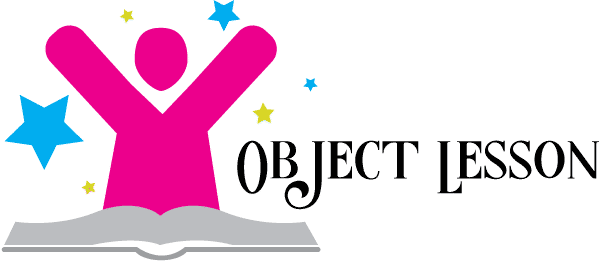

What you need:
GENTLY and SLOWLY place paper clip by paper clip in the very full glass of water. Have your students watch as the glass gets fuller and fuller but never topples over and spills everywhere. Relate how this can sometimes be like our lives. We can feel like we are always held down and we don't know if we can fit any more into our schedule, but we can fit that two pages of the scriptures or that morning and night prayer. It all depends on whether we try hard enough or not.
(Careful, if you add TOO many paper clips, the cup COULD spill over. Don't go too far, just far enough to get your point across.)

John 1–3. The Lord’s titles teach us about His life and mission. (25–30 minutes)
Bring a loaf of bread, a lightbulb, a glass of water, and a rock to class. Ask: How are each of these objects symbolic of the life of Christ? (You could use John 4:10–15; 6:48; 8:12; Jeremiah 2:13; and Helaman 5:12to show how these objects can symbolize Christ.)
Have students read John 1:1–3, 14; the Joseph Smith Translation of John 1:1–3, 14; and Doctrine and Covenants 93:8–10, looking for why John calls Jesus Christ “the Word.” (Possible answers include that Jesus is the “messenger of salvation” [D&C 93:8], that He personifies the gospel, that He carries out the word of the Father, and that He created the earth under the direction, or word, of the Father.) Have students look quickly through the first three chapters of the Gospel of John searching for titles for Jesus Christ, and write them on the board. (The following list is included for your convenience and is not comprehensive.)
Encourage students to watch for titles of Jesus as they study the New Testament and consider what each one teaches about the life and mission of the Savior.

Matthew 2:13–21. The purposes and work of the Lord cannot be frustrated. (5–10 minutes)
Show the students a glass of water and a teaspoon of sugar. Stir the sugar into the water. Then invite a student to separate the sugar from the water. Read Doctrine and Covenants 121:33 and ask students:
Read Matthew 2:14–21 and ask:
According to verse 14, what role did Joseph and Mary play in stopping Herod’s plan?
To help students apply this principle, ask:

Bring a jar to class and, after reviewing together Luke 2:7, ask class members to fill the jar with various objects that represent ways we spend our time. When the jar is full, invite someone to try to insert a picture of the Savior. What does this analogy suggest about making room for Christ in our lives? What can we do differently to make room for Him?
President Thomas S. Monson taught:
“The formula for finding Jesus has always been and ever will be the same—the earnest and sincere prayer of a humble and pure heart. …
“Before we can successfully undertake a personal search for Jesus, we must first prepare time for him in our lives and room for him in our hearts. In these busy days there are many who have time for golf, time for shopping, time for work, time for play—but no time for Christ.
“Lovely homes dot the land and provide rooms for eating, rooms for sleeping, playrooms, sewing rooms, television rooms, but no room for Christ.
“Do we get a pang of conscience as we recall his own words: ‘The foxes have holes, and birds of the air have nests; but the Son of man hath not where to lay his head.’ (Matt. 8:20.) Or do we flush with embarrassment when we remember, ‘And she brought forth her firstborn son, and wrapped him in swaddling clothes, and laid him in a manger; because there was no room for them in the inn.’ (Luke 2:7.) No room. No room. No room. Ever has it been.
“As we undertake our personal search for Jesus, aided and guided by the principle of prayer, it is fundamental that we have a clear concept of him whom we seek. The shepherds of old sought Jesus the child. But we seek Jesus the Christ, our Older Brother, our Mediator with the Father, our Redeemer, the Author of our salvation; he who was in the beginning with the Father; he who took upon himself the sins of the world and so willingly died that we might forever live. This is the Jesus whom we seek” (“The Search for Jesus,” Ensign, Dec. 1990, 4–5).

Before glass begins, tape the label "holy ghost" to the eyeglasses.
Ask the person to try and read a section of scripture without his or her glasses. Why is it difficult?
Then ask the person to read the scriptures with her Holy Ghost Goggles on. It's easier!
How is reading with eye glasses on like feeling the Holy Ghost? Ah, it's clear!
How can our scripture study be enhanced by reading with the spirit influencing us? How do we receive that power? (by being baptized, pray to hear and understand the holy ghost when we read)
How does reading with eyeglasses on help you understand how to recognize the holy ghost when it's prompting you? What does the Holy Ghost feel like?

By Kristen Danielson
I saw this object lesson I am going to use tomorrow for teaching #dandc59
Have someone help you stretch a line of string/tape (approx. 10 feet long) across the floor.
2. Invite someone to do the following:
a. Stand at one end of the string.
b. Close their eyes.
c. Try to walk the entire length without stepping off the string.
3. The person will probably be off the string at least six inches by the time he/she reaches the other end of the string. Ask:
a. “Imagine the string is the length of a football/soccer field. How far off would you be at the end of the string?”
b. Imagine the string is a mile/kilometer long. How far off would you be at the end of the string?”
4. Ask the same person to do the following:
a. Return to the starting end of the string.
b. Close his/her eyes.
c. Take six steps and on the seventh step open his/her eyes and adjust back on the string.
5. The person will probably be no more than an inch or so off the string when he/she reaches the end. Ask:
a. “Imagine the string is the length of a football/soccer field. How far off would you be at the end of the string?”
b. Imagine the string is a mile/kilometer long. How far off would you be at the end of the string?”
6. Ask, “What does this have to do with the Sabbath Day?” Help them see the comparison between the opening of your person’s eyes on the seventh step and the Sabbath that Heavenly Father has given us every seven days.

by Judi Kelly
To go along with the principle: If we faithfully try to fulfill the roles the Lord has for us, He can do great things in our lives.
Give each student in the class a different tool (car tools, home improvement tools, cooking tools, etc.). Tell each student that they have one minute to come up with as many uses for the tool as they can possibly think of and to also figure out the tools original purpose and function.
Application: God has placed us here on earth for a purpose. Many people don’t know what the purpose of their lives are, what they are supposed to be doing. How do you find out what the purpose of the tool is? You read the owners manual or instruction book. What are the instruction books for the children of God? The scriptures and words of the prophets.
This activity can also be used to teach about being an effective instrument in the hands of the Lord. The Lord has placed within all of us talents, abilities, and gifts that he would like us to develop to use for a variety of reasons and purposed in his kingdom (some of them we don’t know about, just like the tools we were given)."


Ask a class member to make a paper airplane, or make one yourself. Tape a coin, rock, or weight to one side of the airplane. Stand on the same side of the room as the class members, and ask a class member to throw the airplane gently toward the other side of the room. Next, pick up the airplane and remove the taped object. Have the class member throw the airplane again. After the class member has done so a few times, put the airplane away, and ask the following questions:
How can just one small weight keep the plane from flying correctly?
Explain that taping a weight to the wing of a paper airplane is like holding a grudge. When we refuse to forgive others, we carry around a weight that keeps us from traveling the straight and narrow path our Father in Heaven wants for us. It is important to forgive others so that we can enjoy the companionship of the Holy Spirit and grow spiritually.
(This object lesson can also be likened to repentance. One small sin can keep us from “flying” back to our Father. We need Christ’s atoning sacrifice to make us clean. ~Jenny)
Source: Lesson 34: Forgiving Others, Preparing for Exaltation: Teacher’s Manual, 197

Repentance like soap should be used frequently!
And how great is his joy in the soul that repenteth!
-D&C 18:13
I used this handout and attached a bar of soap to it. I am sure you could add other cute sayings that tie in with soap and repentance as well.

In one of my lessons we were talking about avoiding Satan's deception, I made a chocolate covered marshmallow and a chocolate covered cotton ball. I showed both treats to the class and had a volunteer come and cut them open to see what was in the middle. To illustrate my point, I gave a quote from Elder James E. Faust: "Much of what comes from the devil is alluring and enticing. It glitters and is appealing to the sensual parts of our nature... He comes into our lives as a thief in the night. His disguise is so perfect that it is hard to recognize him or his methods. He is a wolf in sheep’s clothing... I strongly urge you that if there is any question in your minds or hearts about whether your personal conduct is right or wrong, don’t do it. Each of us has moral agency, and the gift of the Holy Ghost will sharpen our impressions of what is right and wrong, true and false."
I then shared a story from my own childhood: When I was in middle school, I was eating lunch with my friends one day. One of them gave me a treat she had made at home. After I had finished my own lunch, I took a huge bite of this treat. I quickly discovered it was no "treat" at all. It was a chocolate covered cotton ball. I had been tricked and deceived. I had forgotten that day was April Fool's day, but it didn't matter and the joke was anything but funny. I DID feel like the fool and I went to hide in the bathroom and cry. Whenever we fall prey to temptation and sin, don't we have similar feelings of foolishness, shame, sadness, and regret? Were we not also deceived?
At the end of the lesson I gave them a chocolate covered marshmallow to take home and the quote by Elder Faust.